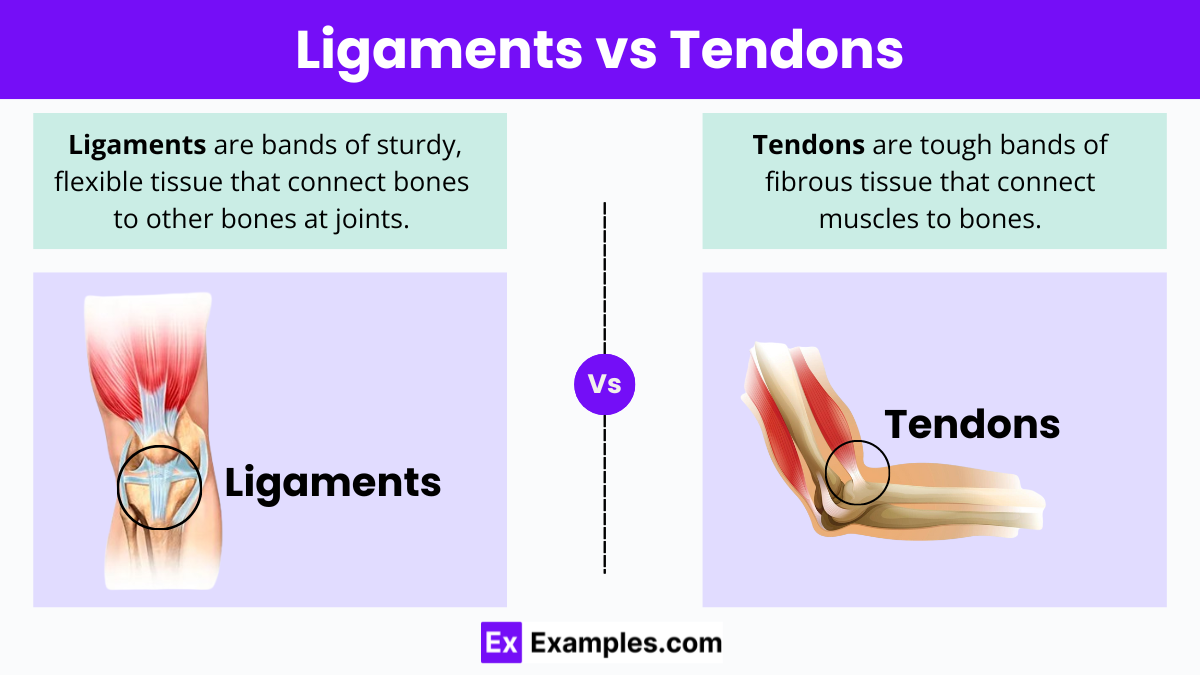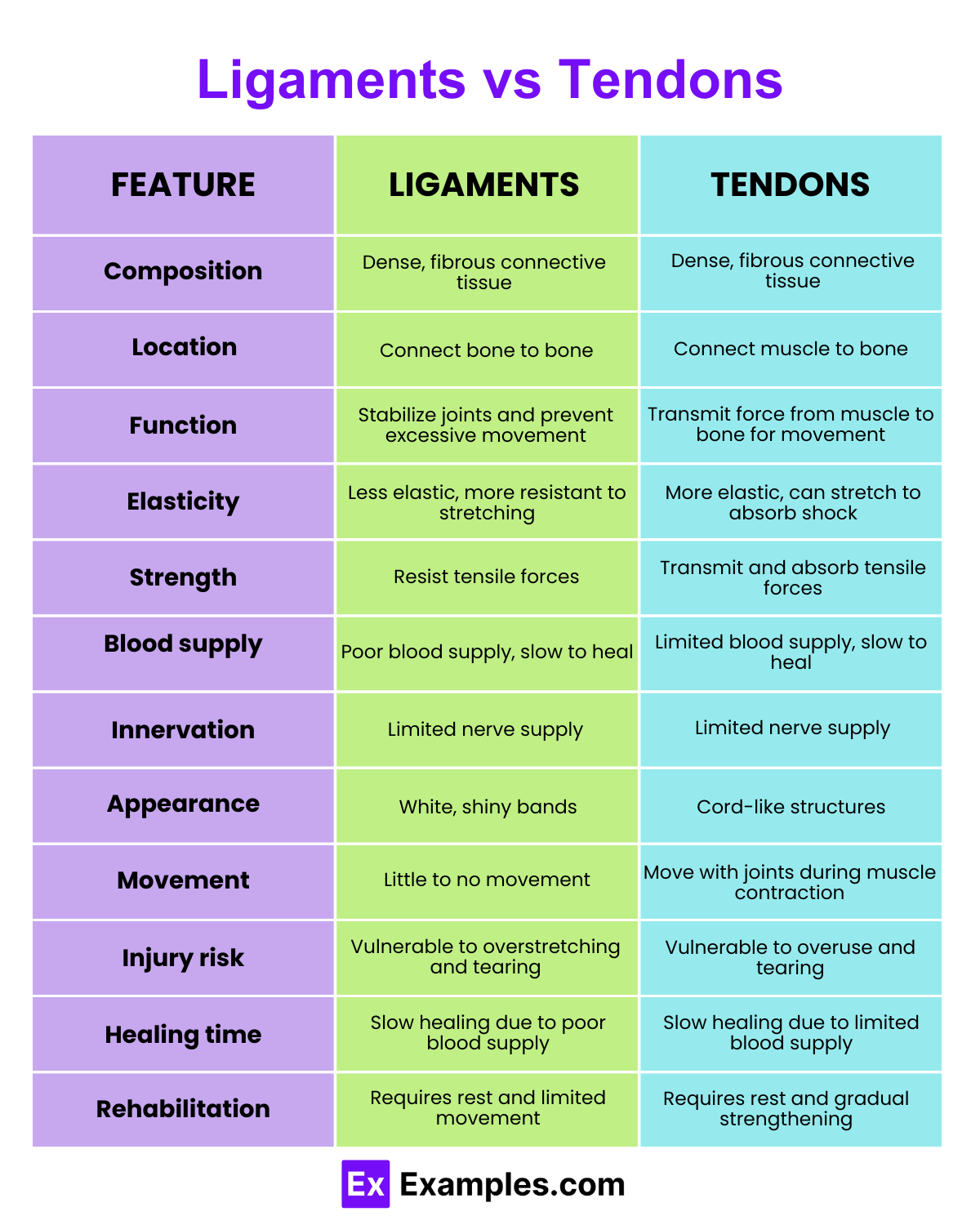Which of the following structures connects bone to bone?
Ligament
Tendon
Muscle
Cartilage


Identifying the specific type of soft tissue involved in an injury is essential for effective treatment and quick recovery. Tendons and ligaments are both crucial fibrous connective tissues, but they have distinct roles within the body. Tendons attach muscles to bones, enabling movement, while ligaments connect bones to other bones, ensuring joint stability. Despite their strength, both tissues have limited blood supply, making them slow to heal when injured. Understanding these differences is key to managing and recovering from soft tissue injuries effectively.
Tendons: Tendons are tough bands of fibrous tissue that connect muscles to bones. They play a crucial role in movement by transmitting the force generated by the muscle’s contraction to the bone, thus causing the bone to move. Tendons provide support and elasticity, allowing for smooth, coordinated movements. Their structure, consisting of parallel fibers, combines strength with a slight flexibility, which is necessary for cushioning and supporting muscular and skeletal actions.
Ligaments: Ligaments are bands of sturdy, flexible tissue that connect bones to other bones at joints, or they can support and hold organs in place. They are primarily responsible for providing stability to the joints, preventing excessive movement that could lead to injury. The interwoven fibers in a crisscross pattern grant ligaments the strength and flexibility needed for maintaining joint stability and optimal function. Ligaments also help in defining the range of motion of a joint, contributing to the body’s overall stability and posture.

| Feature | Ligaments | Tendons |
|---|---|---|
| Definition | Ligaments are tough, elastic bands of connective tissue that connect bones to other bones at joints. | Tendons are tough, fibrous connective tissues that attach muscles to bones. |
| Function | Primarily responsible for providing stability to joints and limiting their movement to prevent dislocation. | Serve to move the bone or structure when the muscle contracts. |
| Composition | Composed of collagen fibers, which provide strength and flexibility. | Composed predominantly of collagen fibers, making them strong and slightly elastic. |
| Elasticity | Less elastic compared to tendons, allowing them to provide joint stability. | More elastic than ligaments to help absorb the mechanical forces that muscles exert on bones. |
| Location | Found at joints, such as knees, elbows, ankles, and shoulders. | Typically located at the ends of muscles, where they attach to bones. |
| Injury Type | More prone to sprains when overstretched. | More prone to strains or tears from overuse or abrupt, forceful movements. |
| Healing Time | Generally heal slower than tendons due to lesser blood supply. | Heal relatively faster than ligaments because of a better blood supply. |
| Examples | Anterior cruciate ligament (ACL) and lateral ligaments in the ankle. | Achilles tendon in the heel and the patellar tendon in the knee. |
| Blood Supply | Ligaments generally have a poor blood supply, which is why they are white in appearance and slow to heal. | Tendons have a slightly better blood supply than ligaments, facilitating somewhat quicker healing. |
| Flexibility | Provide flexibility at joints but within a limited and controlled range to prevent excessive movement that could lead to injuries. | Allow for the transmission of the considerable force from muscle contractions to bones, enabling movement. |
| Clinical Significance | Often involved in joint injuries and are a common focus in sports medicine. Sprains involving ligaments can lead to chronic pain and instability if not properly treated. | Tendinitis and tendon ruptures are common sports injuries that require immediate attention to minimize long-term mobility issues. |
| Structural Role | Act as passive stabilizers of joints and contribute to proprioceptive feedback mechanisms that help in joint positioning. | Play an active role in biomechanics, being integral to the function of levers in the body which muscles utilize to produce movement. |
Ligaments connect bones at joints, while tendons attach muscles to bones, facilitating movement.
Both are severe, but torn ligaments often lead to joint instability, possibly requiring longer recovery.
Remember: Tendons attach muscle to bone, aiding movement. Ligaments link bones, stabilizing joints.
Tendon injuries affect movement and muscle attachment points; ligament injuries impact joint stability.
Torn ligaments can heal over time with rest and proper treatment, but severe cases may need surgery.
Text prompt
Add Tone
10 Examples of Public speaking
20 Examples of Gas lighting
Which of the following structures connects bone to bone?
Ligament
Tendon
Muscle
Cartilage
What is the primary function of tendons?
Connect bone to bone
Connect muscle to bone
Protect organs
Store fat
Which type of tissue are both ligaments and tendons composed of?
Epithelial tissue
Connective tissue
Nervous tissue
Muscle tissue
What type of collagen is most commonly found in tendons?
Type I collagen
Type II collagen
Type III collagen
Type IV collagen
Ligaments primarily function to:
Facilitate muscle contractions
Maintain joint stability
Transport nutrients
Generate heat
Which structure is more elastic, allowing for some stretch?
Ligament
Tendon
Bone
Cartilage
Achilles tendon connects which muscle to the heel bone?
Quadriceps
Biceps
Gastrocnemius
Deltoid
Injury to which structure is commonly referred to as a sprain?
Ligament
Tendon
Muscle
Bone
Which structure can regenerate faster due to better blood supply?
Ligament
Tendon
Muscle
Bone
What connects the patella to the tibia?
Ligament
Tendon
Muscle
Cartilage
Before you leave, take our quick quiz to enhance your learning!

